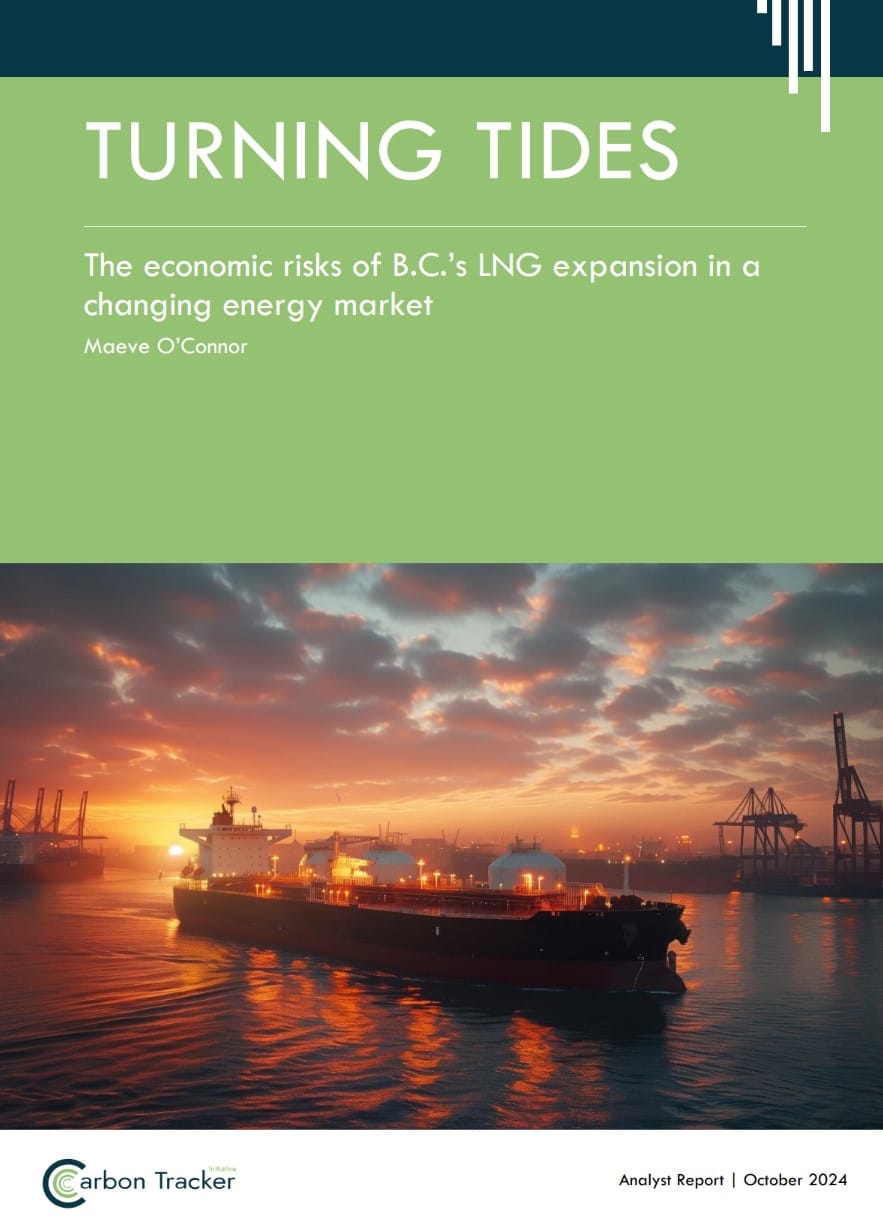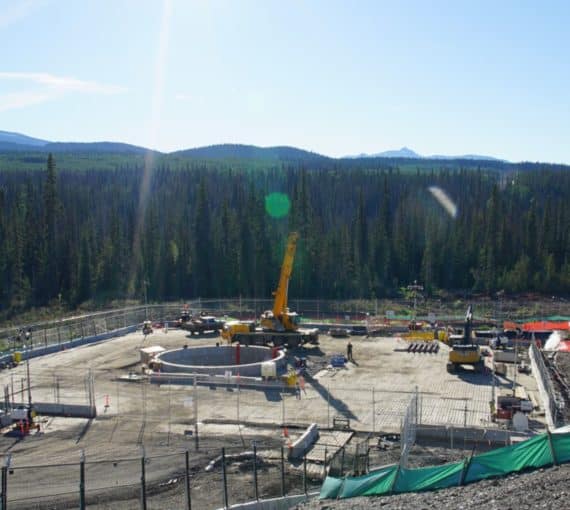Turning Tides: The economic risks of B.C.’s LNG expansion in a changing energy market

Written by Carbon Tracker — an international financial think tank that specializes in the impact of the energy transition on capital markets — this report compares the economics of all worldwide currently proposed liquefied natural gas projects that have yet to reach a final investment decision. It concludes that the four LNG terminals still awaiting final investment decision in British Columbia are likely to lose out to competition from producers in Qatar, the U.S. and Mozambique, which can supply significant volumes at lower prices.
It warns that B.C.’s proposed LNG expansion carries significant economic risks for private and public sector proponents.
Read the report hereWhat not to do in the midst of the climate crisis
Nothing “natural” about fracking
Liquefied natural gas isn’t “natural.” LNG in British Columbia will be produced using fracked gas from the northeast corner of the province. Hydraulic fracturing, better known as “fracking,” is the standard practice in thousands of wells that dot the landscape, particularly in the northeast of the province.
Fracking pumps toxic chemicals deep into the earth at high intensity to extract gas. Research shows that fracking poses a serious health risk, especially to children, the elderly and those with compromised health. It uses millions of litres of water and can seriously contaminate surface and groundwater. It’s been banned in Australia, Britain, France, Germany and Spain.
LNG projects in B.C. and climate pollution
Beyond the small Tilbury LNG plant in Delta, the only LNG project under construction in B.C. is LNG Canada Phase 1 in Kitimat. The provincial government approved LNG Canada Phase 2 and the consortium of big oil and gas companies that make up LNG Canada will soon decide whether to proceed with Phase 2. The day that LNG Canada Phase 1 starts operating, it will become the single biggest source of climate pollution in the province.
Phase 1 and Phase 2 would make it essentially impossible for B.C. to meet its climate targets because of climate pollution caused by the massive industrial operations. The way climate pollution is tracked internationally means that B.C. and Canada are not held responsible for the emissions created when LNG is burned in importing countries.
Three other LNG projects have been approved by the B.C. government but are not currently under construction. It’s likely that more LNG projects will be proposed.
The science is clear. If we want a climate safe future there can be no more fossil fuel development.
The science is clear. If we want a climate safe future there can be no more fossil fuel development.
Stop LNG from fueling climate chaos
During the two-year anniversary of a deadly 2021 B.C. heat dome, the David Suzuki Foundation launched an advertising campaign about “natural” and liquefied natural gas (LNG) to counter misleading fossil fuel industry greenwashing. The campaign is focused on British Columbia but speaks to issues of urgent national and global importance, as B.C. is home to the sixth largest fossil fuel reserve in the world and Canada’s biggest carbon bomb.
Indigenous Peoples, Coastal GasLink and LNG Canada
Coastal GasLink is a 670-kilometre pipeline being built to transport fracked gas from northeast B.C. to LNG Canada’s facility in Kitimat. Approximately 400 kilometres of the pipeline has been built.
The pipeline runs through Wet’suwet’en traditional territory. Wet’suwet’en Hereditary Chiefs, recognized by the Supreme Court of Canada as the rightful decision-making body over 22,000 square kilometres of extraordinarily beautiful land and water, oppose construction of the pipeline.
Some Indigenous Peoples support LNG development and some don’t.
We respect and support Indigenous Peoples and the choices they make on their path out of colonialism and its many forms of ongoing systemic violence.
Leapfrog to renewable energy
Fossil fuel lobbyists and the companies they work for market products such as LNG as a bridge fuel that will allow some countries to get off coal and onto what they claim is a cleaner alternative. Neither of these claims is necessarily true.
The international Institute for Sustainable Development says “gas is not a bridge fuel, it’s a wall.”
Methane is a far more powerful form of climate pollution than carbon dioxide — 86 times more powerful over 20 years. Extensive methane pollution along the LNG supply chain and greenhouse gases produced when LNG is burned make it no better than coal in addressing the climate crisis. There’s little evidence that liquefied natural gas will be used to replace coal, as claimed.
We need to leapfrog to renewable energy and skip the false choice of LNG as a bridge fuel.
A bad economic deal
The LNG industry is being built entirely for export. Fracked gas will be sent by pipeline from northeast B.C. to the coast. There, it will be turned into LNG and exported to primarily Asian markets. The LNG Canada facility in Kitimat, along with the controversial Coastal GasLink pipeline, have so far received $6 billion in various forms of government support.
That’s $6 billion that could have been invested in ramping up the transition to renewable energy while managing the wind down of fossil fuel production and ensuring a just transition for affected workers.
By the time LNG Canada is ready to begin shipping overseas, the market for LNG will have shrunk and/or been served fully by other low-cost producers. LNG Canada and other proposed projects could fail financially and end up as stranded assets.
“Whether you consider LNG from a climate, economic or Indigenous rights perspective, it’s the wrong choice for a liveable planet and climate justice. Far better for B.C. to take bold, visionary steps on renewable energy.”
John Young, B.C. Energy Transition Strategist
Top 10 reasons to say NO to LNG in B.C.

The science is clear. If we want a liveable planet for ourselves, future generations and countless other species, we cannot build any more fossil fuel projects anywhere.
Governments need to stop listening to oil and gas companies and focus on science and a bold, beautiful vision for the future.
Expert views
A changing energy market makes expanding LNG in B.C. risky business
If private sector proponents wish to bear these risks, they can but before liquefied natural gas, or LNG, projects are given priority access to publicly funded clean electricity, the government needs to take an objective look at the likely return on investment.
Senior Climate Policy Adviser
Premier David Eby should follow President Joe Biden’s lead on LNG
The B.C government is considering a big expansion of the LNG export industry just as the U.S. is hitting pause due to economic, energy security and climate reasons. Premier Eby should follow the U.S. lead: Pause, reflect and walk away from LNG.
Former B.C. Energy Transition Strategist
Climate — when the unprecedented becomes the precedent
Unprecedented fires. Unprecedented drought. Unprecedented heat. It seems the new precedent is the unprecedented in the now thoroughly unignorable climate crisis.
Former B.C. Energy Transition Strategist
Extreme fire season is here early. How will our leaders respond?
With the arrival of extreme fires extremely early in Alberta and B.C., people’s lives, homes and health are, again, at risk because of the choices we make about how to live on this planet. The Foundation’s energy transition strategist John Young argues that we must use nature’s warning to turn up the heat on decision-makers and inspire them to make bold choices for a clean economy that gets us off fossil fuels.
Former B.C. Energy Transition Strategist
Big Oil and Gas is shameless
There’s a lot of competition for the dubious honour of most shameless conduct in public. But fossil fuel companies making obscene profits while asking our governments for more and more money (your money) has to be near the top of the list.
Former B.C. Energy Transition Strategist



